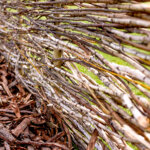How to Make a Wattle Fence with Natural Branches
How to make a wattle fence: Learn to create a charming, eco-friendly wattle fence using natural branches with our step-by-step guide.
Equipment
- sledgehammer for driving stakes into the ground
- metal rod to help with creating holes for upright stakes
- small hand saw for cutting branches
Materials
- wood stakes
- long branches
Instructions
- Measure out the area where you want to build your wattle fence, and decide on the desired height.
- Survey your area, and see how long the branches you will be using area. Based on that, decide how far apart you will place your stakes.
- Measure out regular intervals for the stakes, and drive them into the ground. Our soil is pretty hard, so we had to use a metal rod to create a hole first, before driving the upright stakes into the ground. You can use different materials for the stakes, we decided to go with impregnated wood that we purchased. However you can also use thicker branches, or even metal stakes.
- Once all your upright stakes are in place, it's time to start weaving with the wattle method. This is best show visually, so take a look at the video above to see this done. In summary, you place a long branch behind one stake, and weave it in front of the other, so that it stays put in place. Start at the bottom and continue moving upwards, each time placing the branches on the opposite side of the stake.
- You will soon start to see the wattle design emerge. When you get to the end post, make sure to line up the long stick ends evenly, to create a neat finish.
Notes
The number of stakes and amount of branches depends on how long of a fence you're building. You also need to evaluate how long the branches you will be using/sourcing are, and that will dictate how far part the stakes need to be.
Tips
- Choose the right season: Winter and early spring are ideal times for gathering and working with willow and hazel as they are more flexible.
- Select flexible branches: Willow and hazel are ideal due to their flexibility.
- Soak the branches: If they are too dry, soak them in water for a few hours to make them more pliable.
- Clear the area: Remove any grass or debris where the fence will stand.
- Mark the stake positions: Use string and measuring tape to ensure evenly spaced stakes.
- Check alignment: Ensure stakes are aligned properly by sighting down the line and adjusting as necessary.
